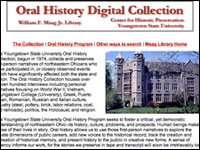Oral History Digital Collection

These full-text first-person narratives present the voices of more than 2,000 people from northeast Ohio discussing issues significant to the state and the nation. These oral histories, collected since 1974, focus on a range of topics such as ethnic culture, including African American, Greek, Irish, Italian, Jewish, Puerto Rican, Romanian, and Russian, and industry, such as steel, pottery, brick, coal, and railroads.
Others discuss labor relations, including women in labor unions, wars (World War II, Vietnam, Gulf War), college life (including the shootings by National Guard troops at Kent State in 1970), the Holocaust, and religion. Subject access is available through more than 200 topics listed alphabetically.